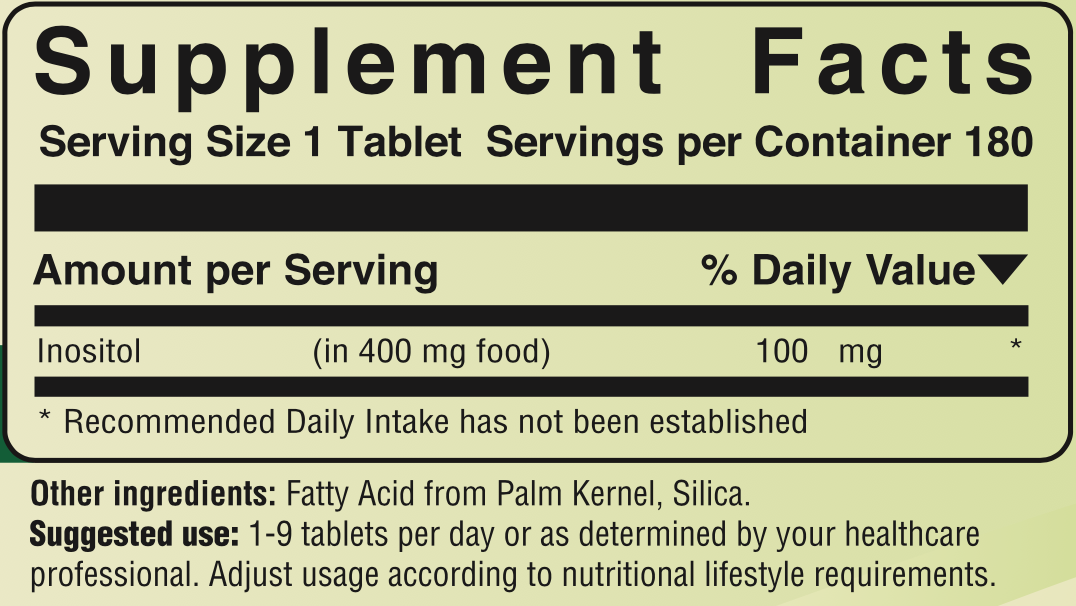
Inositol ComplexTM
180 Tablets $36.98
180 Tablets $36.98
Inositol was once called vitamin B-8 [1,2]. It is a lipotrophic factor, a chelater, and seems to have positive effects on the immune system [2,3]. It also shares many of choline's functions.

When it comes to moods, it basically helps people feel better in various ways.
In healthy people, more inositol is in the body than any other vitamin
except B-3. Inositol metabolism is sometimes affected by
diabetes, renal disease, respiratory distress syndrome, multiple
sclerosis, and hypercholesterolemia. Inositol has been used as
nutritional support for people with brain, kidney, bone marrow, skin,
hair, mood, muscular control, and blood cholesterol concerns. Inositol
is involved with the formation of phospholipids as well as cholesterol
metabolism. Inositol phospholipids are integral parts of cellular and
subcellular membranes and modulate many enzymes including adenosine
triphosphate (ATP). Inositol has nutritional efficacy as a
lipotrophic factor and thus assists in burning hepatic and intestinal
triglycerides. Many diabetics have lower inositol levels than
non-diabetics; treatment with dietary inositol has been shown to
normalize neural inositol levels, ATP activity, and motor conduction
velocities for diabetics. Recent reports suggest that since inositol is
a precursor of phophatidylinositol biphosphate which is affected by
certain noradrenalin and serotonin receptors, it may be helpful for
people with depression, panic disorder, and obsessive-compulsive
disorder (OCD) at high levels [2]. Clinically, it is often
recommended for OCD.
Web MD states, “Inositol is used for diabetic nerve pain, panic disorder, high cholesterol, insomnia, cancer, depression, schizophrenia, Alzheimer’s disease, attention deficit-hyperactivity disorder (ADHD), autism, promoting hair growth, a skin disorder called psoriasis, and treating side effects of medical treatment with lithium. Inositol is also used by mouth for treating conditions associated with polycystic ovary syndrome, including failure to ovulate; high blood pressure; high triglycerides; and high levels of testosterone” [8].
The
plant source inositol known as phytate [9] “has strong chelating power
for doubly charged metal ions” and “is a putative antiproliferative
agent and may have antioxidant activity” [3]. Thus, inositol in
Saccharomyces cerevisiae is preferred by some for its chelating
abilities.
Certain plant foods contain phytate as well as myo-inositol. “Myo-inositol may have antidepressant and antianxiety activity…Myo-inositol
has exhibited positive effects in a number of studies related to
depression, panic attacks, and obsessive-compulsive disorder…In
general, it appears that myo-inositol may be effective in many of the
same disorders in which the SSRIs have shown some usefulness” [3].
Inositol is also used clinically for ‘perfectionists’ and some with anger concerns.
The non-food version of inositol is made from phytin processed with
sulfuric acid [10]. Inositol is a lipotrophic factor, and is also
necessary for hair growth. While nutritional yeast is probably the best
source of inositol, it is also found in fruits, lecithin, legumes,
meats, milk, unrefined molasses, raisins, vegetables, and whole grains
[11].
Web MD states, “Inositol
might balance certain chemicals in the body to possibly help with
conditions such as panic disorder, depression, obsessive-compulsive
disorder, and polycystic ovary syndrome” [8]. In the body,
inositol also has an effect on calcium and magnesium levels [12], hence
this could explain some of the claimed results.
“Inositol is found
in brewer’s yeast” [11]. “Dosages range from 500 milligrams to 4
grams daily taken with meals” [3].
Nutrition from food, what a concept!
References
[1] Zeisel S. Choline. In: Modern Nutrition in Health and
Disease, 11th ed. Wolters Kluwer| Lippincott Williams &
Wilkins, 2012: 416-426
[2] Neumann C, ed. Serious Nutrition. FR International, Canada, 2005
[3] Hendler SS, Rorvik DM. PDR for Nutritional Supplements, 2nd
edition. Thomson Reuters, 2008, Montvale (NJ)
[4] Whelan WJ. What’s in a Name? Vitamin B4. IUBMB Life, 57(2): 125, February 2005
[5] Vera Reader. The assay of vitamin B4. Biochem J. 1930; 24 (6): 1827–31
Choline.
[6] WebMD.
http://www.webmd.com/vitamins-supplements/ingredientmono-436-CHOLINE.aspx?activeIngredientId=436&activeIngredientName=CHOLINE
viewed 07/02/13
[7] Castell LM, Burke LM, Stears SJ, et al. A-Z of nutritional
supplements: dietary supplements, sports nutrition foods and ergogenic
aids for health and performance. Part 9. Br J Sports Med.
2010;44(8):609-611
[8] Inositol. Web MD.
http://www.webmd.com/vitamins-supplements/ingredientmono-299-INOSITOL.aspx?activeIngredientId=299&activeIngredientName=INOSITOL
viewed 05/14/13
[9] Andlid TA, Veide J, Sandberg AS. Metabolism of extracellular
inositol hexaphosphate (phytate) by Saccharomyces cerevisiae. Int J.
Food Microbiology. 2004;97(2):157-169
[10] Vitamin-Mineral Manufacturing Guide: Nutrient Empowerment, volume
1. Nutrition Resource, Lakeport (CA), 1986
[11] Balch JF, Balch PA. Prescription for a Nutritional Healing, 2nd
ed. Avery Publishing, Garden City Park (NY), 1997
[12] Rudd RR, Shils M. Magnesium. In Modern Nutrition in Health
& Disease, 10th ed. Lippincott Williams & Wilkins, 2006, p. 224.
Some of these studies (or citations) may not conform to peer review standards, therefore, the results are not conclusive. Professionals can, and often do, come to different conclusions when reviewing scientific data. None of these statements have been reviewed by the FDA. All products distributed by Doctors’ Research, Inc. are nutritional and are not intended for the treatment or prevention of any medical condition.
 |
||
|
||